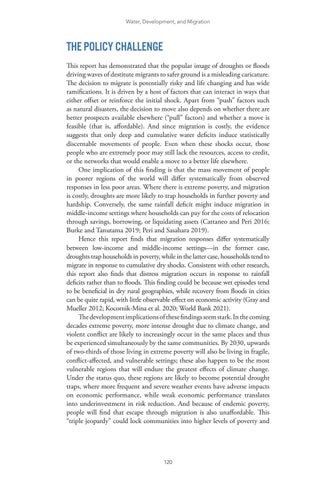Water, Development, and Migration
THE POLICY CHALLENGE This report has demonstrated that the popular image of droughts or floods driving waves of destitute migrants to safer ground is a misleading caricature. The decision to migrate is potentially risky and life changing and has wide ramifications. It is driven by a host of factors that can interact in ways that either offset or reinforce the initial shock. Apart from “push” factors such as natural disasters, the decision to move also depends on whether there are better prospects available elsewhere (“pull” factors) and whether a move is feasible (that is, affordable). And since migration is costly, the evidence suggests that only deep and cumulative water deficits induce statistically discernable movements of people. Even when these shocks occur, those people who are extremely poor may still lack the resources, access to credit, or the networks that would enable a move to a better life elsewhere. One implication of this finding is that the mass movement of people in poorer regions of the world will differ systematically from observed responses in less poor areas. Where there is extreme poverty, and migration is costly, droughts are more likely to trap households in further poverty and hardship. Conversely, the same rainfall deficit might induce migration in middle-income settings where households can pay for the costs of relocation through savings, borrowing, or liquidating assets (Cattaneo and Peri 2016; Burke and Tanutama 2019; Peri and Sasahara 2019). Hence this report finds that migration responses differ systematically between low-income and middle-income settings—in the former case, droughts trap households in poverty, while in the latter case, households tend to migrate in response to cumulative dry shocks. Consistent with other research, this report also finds that distress migration occurs in response to rainfall deficits rather than to floods. This finding could be because wet episodes tend to be beneficial in dry rural geographies, while recovery from floods in cities can be quite rapid, with little observable effect on economic activity (Gray and Mueller 2012; Kocornik-Mina et al. 2020; World Bank 2021). The development implications of these findings seem stark. In the coming decades extreme poverty, more intense drought due to climate change, and violent conflict are likely to increasingly occur in the same places and thus be experienced simultaneously by the same communities. By 2030, upwards of two-thirds of those living in extreme poverty will also be living in fragile, conflict-affected, and vulnerable settings; these also happen to be the most vulnerable regions that will endure the greatest effects of climate change. Under the status quo, these regions are likely to become potential drought traps, where more frequent and severe weather events have adverse impacts on economic performance, while weak economic performance translates into underinvestment in risk reduction. And because of endemic poverty, people will find that escape through migration is also unaffordable. This “triple jeopardy” could lock communities into higher levels of poverty and
120



